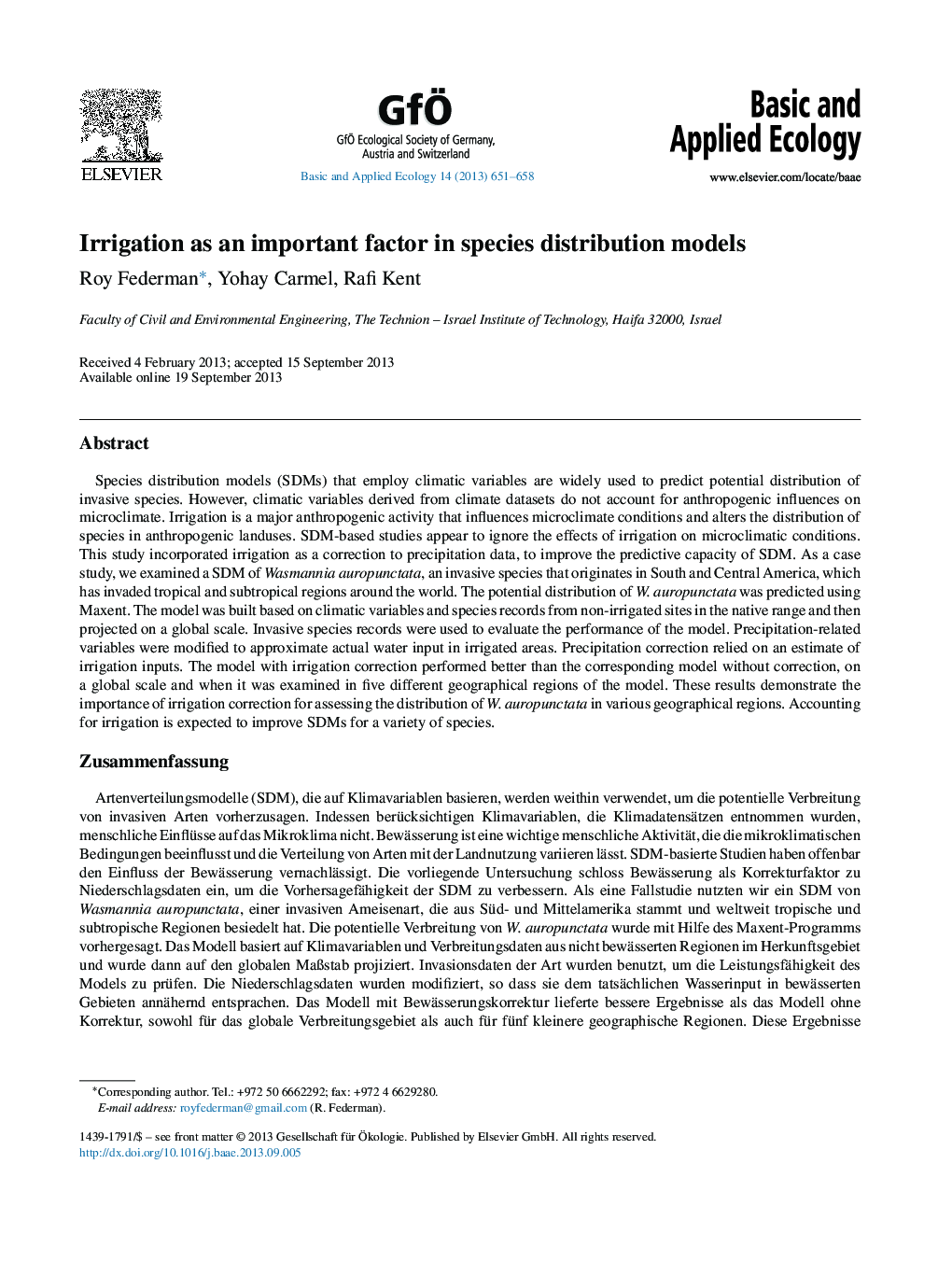| Article ID | Journal | Published Year | Pages | File Type |
|---|---|---|---|---|
| 4383908 | Basic and Applied Ecology | 2013 | 8 Pages |
Species distribution models (SDMs) that employ climatic variables are widely used to predict potential distribution of invasive species. However, climatic variables derived from climate datasets do not account for anthropogenic influences on microclimate. Irrigation is a major anthropogenic activity that influences microclimate conditions and alters the distribution of species in anthropogenic landuses. SDM-based studies appear to ignore the effects of irrigation on microclimatic conditions. This study incorporated irrigation as a correction to precipitation data, to improve the predictive capacity of SDM. As a case study, we examined a SDM of Wasmannia auropunctata, an invasive species that originates in South and Central America, which has invaded tropical and subtropical regions around the world. The potential distribution of W. auropunctata was predicted using Maxent. The model was built based on climatic variables and species records from non-irrigated sites in the native range and then projected on a global scale. Invasive species records were used to evaluate the performance of the model. Precipitation-related variables were modified to approximate actual water input in irrigated areas. Precipitation correction relied on an estimate of irrigation inputs. The model with irrigation correction performed better than the corresponding model without correction, on a global scale and when it was examined in five different geographical regions of the model. These results demonstrate the importance of irrigation correction for assessing the distribution of W. auropunctata in various geographical regions. Accounting for irrigation is expected to improve SDMs for a variety of species.
ZusammenfassungArtenverteilungsmodelle (SDM), die auf Klimavariablen basieren, werden weithin verwendet, um die potentielle Verbreitung von invasiven Arten vorherzusagen. Indessen berücksichtigen Klimavariablen, die Klimadatensätzen entnommen wurden, menschliche Einflüsse auf das Mikroklima nicht. Bewässerung ist eine wichtige menschliche Aktivität, die die mikroklimatischen Bedingungen beeinflusst und die Verteilung von Arten mit der Landnutzung variieren lässt. SDM-basierte Studien haben offenbar den Einfluss der Bewässerung vernachlässigt. Die vorliegende Untersuchung schloss Bewässerung als Korrekturfaktor zu Niederschlagsdaten ein, um die Vorhersagefähigkeit der SDM zu verbessern. Als eine Fallstudie nutzten wir ein SDM von Wasmannia auropunctata, einer invasiven Ameisenart, die aus Süd- und Mittelamerika stammt und weltweit tropische und subtropische Regionen besiedelt hat. Die potentielle Verbreitung von W. auropunctata wurde mit Hilfe des Maxent-Programms vorhergesagt. Das Modell basiert auf Klimavariablen und Verbreitungsdaten aus nicht bewässerten Regionen im Herkunftsgebiet und wurde dann auf den globalen Maßstab projiziert. Invasionsdaten der Art wurden benutzt, um die Leistungsfähigkeit des Models zu prüfen. Die Niederschlagsdaten wurden modifiziert, so dass sie dem tatsächlichen Wasserinput in bewässerten Gebieten annähernd entsprachen. Das Modell mit Bewässerungskorrektur lieferte bessere Ergebnisse als das Modell ohne Korrektur, sowohl für das globale Verbreitungsgebiet als auch für fünf kleinere geographische Regionen. Diese Ergebnisse zeigen, wie wichtig es ist, eine Korrektur für die Bewässerung einzuführen, um die Verbreitung von W. auropunctata zu beschreiben. Generell erwarten wir, dass die Bewässerung zu berücksichtigen, die SDM von vielen Arten verbessern wird.
